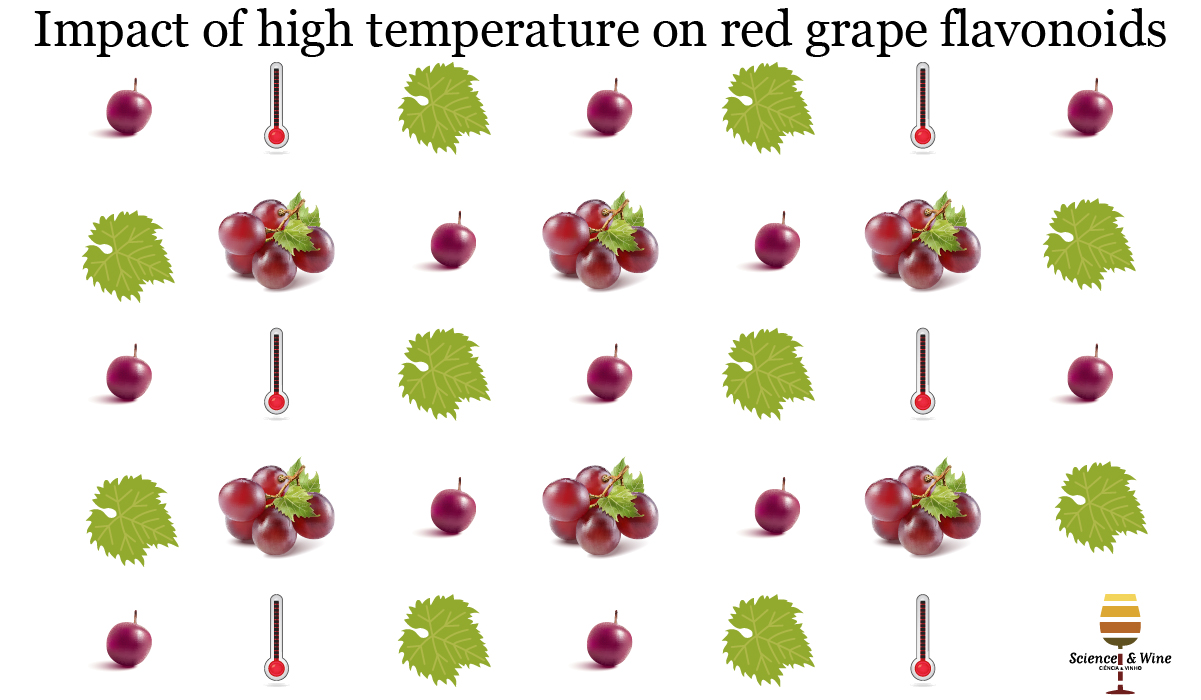By Julia Gouot and Celia Barril
Flavonoids are key compounds for red grape berry and wine quality. Among those, flavonols (UV protectors), anthocyanins (red pigments), flavan-3-ols and tannins (contributing to colour and mouthfeel) are affected by several abiotic factors. In particular, high temperature seems to affect their biosynthesis, accumulation and degradation. Under high temperature, a decrease in total anthocyanins is reported in most cases, while changes in anthocyanin profile, and flavonol and tannin responses are less consistent. This article provides an overview of experimental conditions impacting on flavonoids, including developmental stage, duration, intensity, nocturnal and diurnal temperature ranges, and cultivar diversity of Vitis vinifera L. and interspecific hybrids.
Flavonoids are important secondary metabolites protecting plants against biotic and abiotic stresses and derive from the precursors: phenylalanine, 3-malonyl-CoA and 4-coumaroyl-CoA. They have a common C6-C3-C6 backbone and are divided into sub-families depending on their exact structure and subsequent properties. Three of the main sub-families are flavonols, anthocyanins, and flavan-3-ols giving rise to tannins (Figure 1).
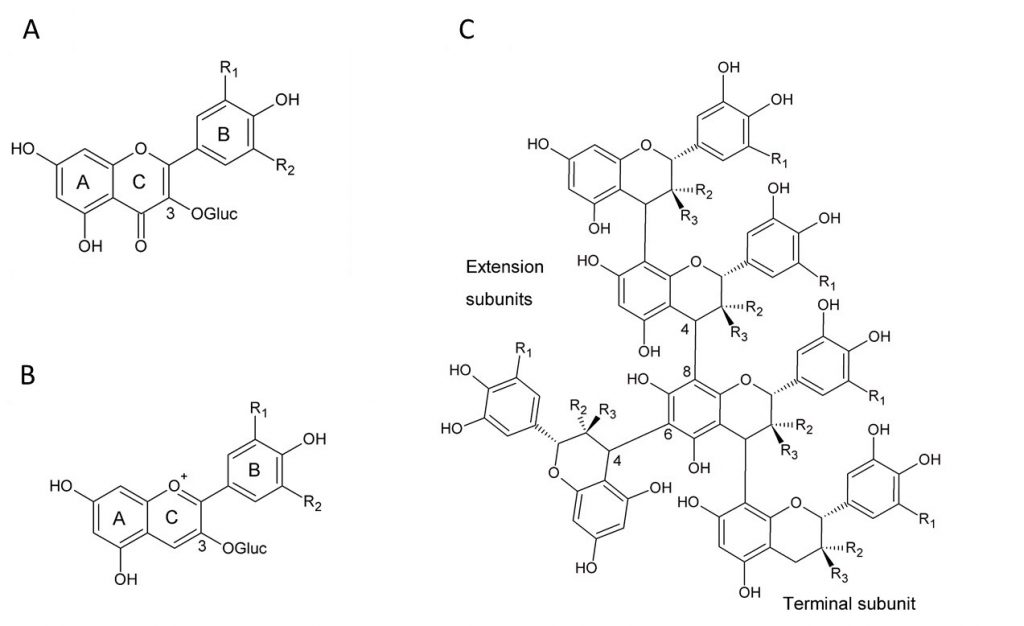
To understand the impact of temperature on flavonoid metabolism, experimental methods are required to prevent interactions with light and water status, as they also affect flavonoid biosynthesis (Downey et al, 2006). Direct methods, which modify the fruit or whole-vine temperature involve controlled environments such as glasshouses, growth chambers/cabinets, small climatic chambers, cold rooms or more complex designs such as passive or heated set-ups in the vineyard called open-top chambers (Bonada and Sadras, 2015). Review of the literature highlighted several key parameters to consider when designing an experiment studying temperature:
Plant material. Several plant materials such as vines of different age, field grown or potted vines, grafted or non-grafted, fruiting cuttings, mutant dwarf vines (microvines) have been used. Grapevine variety must also be considered with vines grown in cool climate regions (Aki Queen, Kadainou R-1, Sangiovese and Pinot Noir) appearing more sensitive to temperature while others, well established in hot climate regions (Malbec and Shiraz), maintain their secondary metabolism under high temperature, although they are still affected by more extreme conditions.
Treatment scale. Temperature treatments can be classified into three levels: whole vine, bunch and detached berry or cell suspension (Figure 2). Whole-vine heating experiments have mainly been conducted in controlled environments or using open-top chambers in the field, often with a broader scope of studying the effect of long-term average warming or heat events on photosynthesis, vine development and subsequent changes in berry composition. Other experiments, designed to only change bunch temperature, used chamber-free systems to investigate the effect of temperature on berry metabolism independently of the canopy (Tarara et al, 2000). To complement field and controlled experiments, single berry studies have also been conducted in vitro on detached berries or cell suspension to gain a detailed understanding of flavonoid degradation mechanisms using isotope tracers.
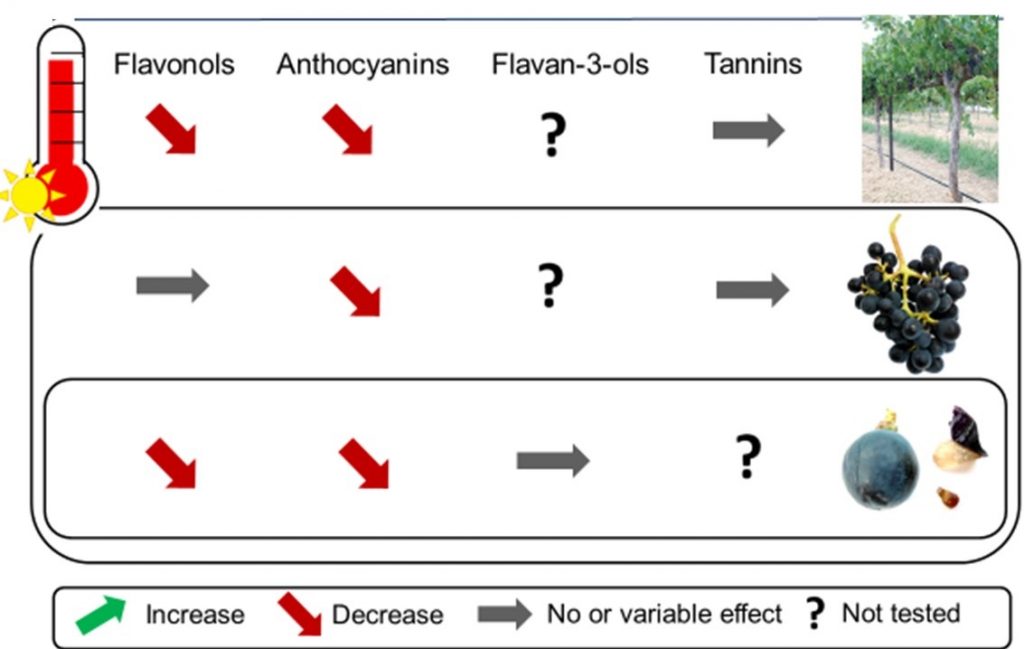
Duration, intensity and timing. Two main categories depending on the duration of the treatment can be differentiated: short-term, when high temperature is applied for a few hours, or several days, up to 14 (Lecourieux et al, 2017); and long-term, when treatments are applied from several weeks to several months or for the whole season. The imposed temperatures also vary from a couple of degrees Celsius to represent future climate conditions, to a high temperature differential reproducing heat event conditions. Treatments can also be applied at different timings in relation to day and/or night.
Phenological stage. The development stage at which berries are exposed to heat stress is probably the most important parameter to consider, with responses varying depending on the phenological stage. Long-term studies have assessed the effect of a higher average temperature during the whole season: from flowering to maturity or the whole year with interruption during winter. Other studies have focussed on specific growth stages targeting gene expression at a given time of berry development and/or ripening. Early berry development experiments are rare, and most studies have commenced just before the onset of véraison or just after. Véraison, a 24-hour phase when berries begin to colour, has been identified as a particularly sensitive window for abiotic stress responses and anthocyanin biosynthesis. Late ripening experiments have shown a less pronounced effect, or none, on flavonoid profiles, but have impacted concentrations due to degradation and changes in berry water content/size due to shrivelling.
Overall, flavonols do not seem to be directly affected by high temperature but rather more indirectly impacted by a change in primary and secondary metabolism. Flavonols are intermediates in the flavonoid pathway and changes in expression of the genes shared with other flavonoids could explain why they are sometimes affected by temperature. On the other hand, anthocyanins are significantly and directly reduced under high day temperature (Figure 2). Several hypotheses suggest there is a complex combination of enzyme inhibition, up- and down-regulation of phenylpropanoid genes as well as anthocyanin degradation. To date, there is insufficient research on flavan-3-ols to conclude on a direct or indirect temperature effect, especially as very early berry development stages such as flowering have not yet been studied. Tannins have been inconsistently affected and no clear patterns have yet been identified (Cohen et al, 2008, Cohen et al, 2012a, 2012b).
Those interested in a longer length report can download the working paper at:
https://academic.oup.com/jxb/article-abstract/70/2/397/5154969
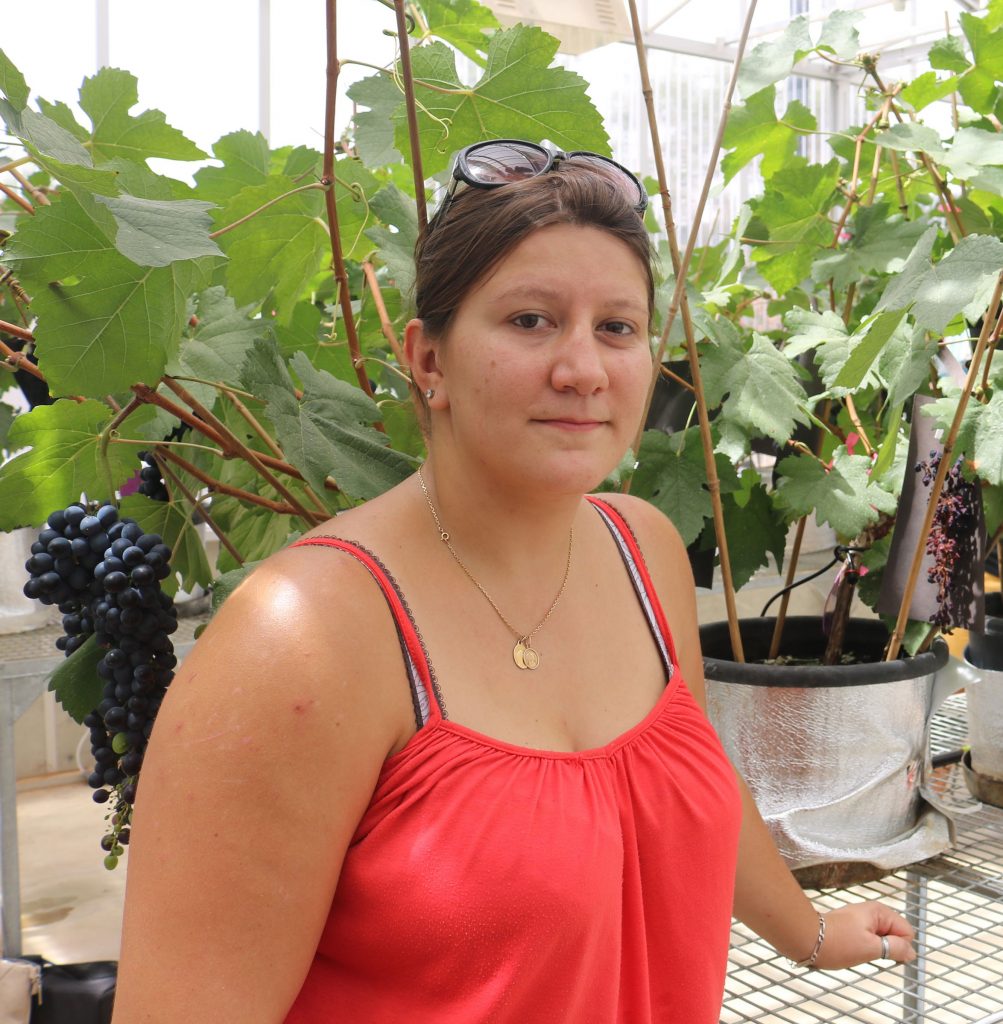
Julia Gout
Julia Gout completed her education in France and graduated with a Diplome National d’Oenologue and Diplome d’Ingenieur Agronome from ENSA Toulouse. She also studied a Research Master in analytical chemistry/chemometrics at AgroParisTech. She first joined the NWGIC (National Wine and Grape Industry Centre, Charles Sturt University, Australia) to undertake her 6-month Master internship with Dr Celia Barril in 2015. In 2016, she was granted with a scholarship and started her PhD with Dr Barril on the effect of high and extreme high temperatures on Shiraz grape tannin composition.
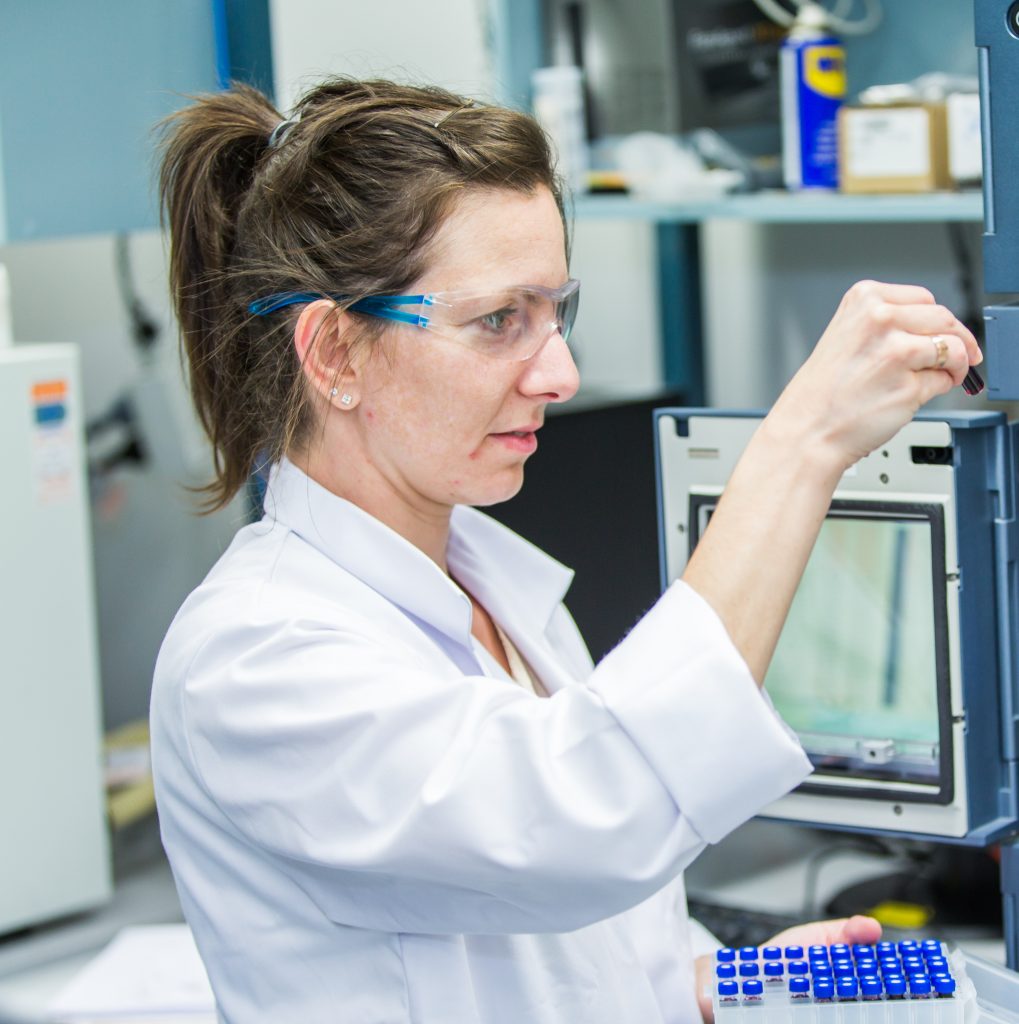
Celia Barril
Dr Celia Barril is a Senior Lecturer in Chemistry at Charles Sturt University (Australia), and currently Course Director in the Faculty of Science. Celia’s research activities make use of her knowledge in organic and analytical chemistry, as applied to current issues in the food, and grape and wine industries. A key theme of her research is the use and development of analytical tools targeted to grape and wine composition, from the impact of canopy management practices and bunch microclimate on grape growing and quality to wine stability quality.
References:
- Bonada M, Sadras VO. 2015. Review: critical appraisal of methods to investigate the effect of temperature on grapevine berry composition. Australian Journal of Grape and Wine Research 21, 1-17
- Cohen SD, Tarara JM, Gambetta GA, Matthews MA, Kennedy JA. 2012a. Impact of diurnal temperature variation on grape berry development, proanthocyanidin accumulation, and the expression of flavonoid pathway genes. Journal of Experimental Botany 63, 2655-2665
- Cohen SD, Tarara JM, Kennedy JA. 2008. Assessing the impact of temperature on grape phenolic metabolism. Analytica Chimica Acta 621, 57-67
- Cohen SD, Tarara JM, Kennedy JA. 2012b. Diurnal temperature range compression hastens berry development and modifies flavonoid partitioning in grapes. American Journal of Enology and Viticulture 63, 112-120
- Downey MO, Dokoozlian NK, Krstic MP. 2006. Cultural practice and environmental impacts on the flavonoid composition of grapes and wine: a review of recent research. American Journal of Enology and Viticulture 57, 257-268
- Gouot JC, Smith JP, Holzapfel BP, Walker AR, Barril C. 2018. Grape berry flavonoids: a review of their biochemical responses to high and extreme high temperatures. Journal of Experimental Botany 70, 397-423
- Lecourieux F, Kappel C, Pieri P, Charon J, Pillet J, Hilbert G, Renaud C, Gomès E, Delrot S, Lecourieux D. 2017. Dissecting the biochemical and transcriptomic effects of locally applied heat treatment on developing Cabernet Sauvignon grape berries. Frontiers in Plant Science 8, 53
- Sadras VO, Bubner R, Moran MA. 2012a. A large-scale, open-top system to increase temperature in realistic vineyard conditions. Agricultural and Forest Meteorology 154–155, 187-194
- Tarara JM, Ferguson JC, Spayd SE. 2000. A Chamber-Free Method of Heating and Cooling Grape Clusters in the Vineyard. American Journal of Enology and Viticulture 51, 182-188

